Bulletin – September 2011 Recent Trends in Counterfeiting
- Download the article 954KB
Abstract
Under the Reserve Bank Act 1959,the Reserve Bank has sole authority to issue banknotes in Australia. As such, a key responsibility of the Reserve Bank is to maintain public confidence in banknotes, so that they remain an effective payment mechanism and a secure store of wealth. This article examines how counterfeiting can impact on this confidence, and counterfeiting trends in Australia and overseas. The article also discusses the strategies the Reserve Bank employs to minimise the risks of counterfeiting and maintain public confidence in banknotes.
The Use of Banknotes
Despite the increasing acceptance of a wide range of alternative payment mechanisms, currency or cash (defined as banknotes and coin) continues to be an essential element of the payments system, both as a means of exchange and a store of wealth. The Reserve Bank's 2010 Consumer Payments Use Study, for example, suggests currency accounts for 62 per cent of payments made by consumers and is used extensively for low-value payments. According to the study, currency is used for around 80 per cent of transactions under $25 and almost half of all transactions between $25 and $50 (Bagnall and Flood 2011). Highlighting the continued importance of currency in the Australian payments system, the value of banknotes on issue has grown by an average of around 6 per cent a year over the past decade, broadly in line with the growth in household consumption (Graph 1).
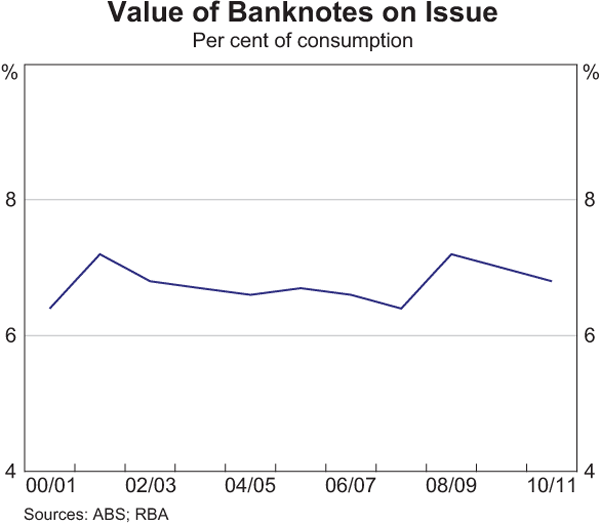
As at June 2011, there were 1.1 billion banknotes, worth $50.1 billion, on issue. The $50 banknote represents the majority of banknotes in circulation, currently accounting for 45 per cent of the number and 49 per cent of the value of banknotes on issue. In contrast, the lowest denominations – the $5 and $10 banknotes – collectively account for less than 23 per cent of the number and only around 3 per cent of the value of banknotes on issue (Table 1).
| At end June | $5 | $10 | $20 | $50 | $100 | Total |
|---|---|---|---|---|---|---|
| 2004 | 0.5 | 0.8 | 2.5 | 15.9 | 14.2 | 34.0 |
| 2005 | 0.5 | 0.8 | 2.6 | 16.7 | 14.9 | 35.6 |
| 2006 | 0.6 | 0.9 | 2.7 | 18.0 | 15.9 | 38.1 |
| 2007 | 0.6 | 0.9 | 2.8 | 19.2 | 16.7 | 40.3 |
| 2008 | 0.6 | 0.9 | 2.7 | 20.1 | 17.7 | 42.1 |
| 2009 | 0.6 | 1.0 | 2.7 | 23.7 | 20.1 | 48.1 |
| 2010 | 0.7 | 1.0 | 2.7 | 23.7 | 20.7 | 48.8 |
| 2011 | 0.7 | 1.0 | 2.8 | 24.3 | 21.2 | 50.1 |
|
Source: RBA |
||||||
The widespread use of currency reflects a number of factors including: the ease with which transactions can be undertaken; the anonymity that currency provides; and the public's confidence in currency as a secure medium of exchange and trusted store of wealth. The importance of this latter factor was particularly highlighted during the global financial crisis when demand for banknotes, particularly higher-value banknotes, increased significantly (Graph 2).

Counterfeiting of Australian Banknotes
One factor that can undermine public confidence in currency as a medium of exchange and store of wealth is counterfeiting. Currency counterfeiting, which has existed for thousands of years, occurs in virtually every country, and while Australia is no exception, counterfeiting rates here are low (Graph 3). Since 2001, on average around 8 counterfeits have been detected each year for every million banknotes in circulation (or 8 parts per million). There have, however, been periods where the counterfeiting rate has risen noticeably. For example, in 2001/02 the activities of a small number of counterfeiters led to an increase in the number of counterfeits detected, but after these operations were disrupted, the counterfeiting rate declined. More recently, there was a temporary increase in counterfeiting in 2010/11, to around 16 parts per million, but following a number of arrests the counterfeiting rate fell sharply to be in line with historical experiences.

Even taking into consideration these periods of increased counterfeiting activity, Australia's counterfeiting rates are low relative to many other economies (Graphs 3 and 4). Counterfeiting rates of between 50 and 100 parts per million are more typical overseas.
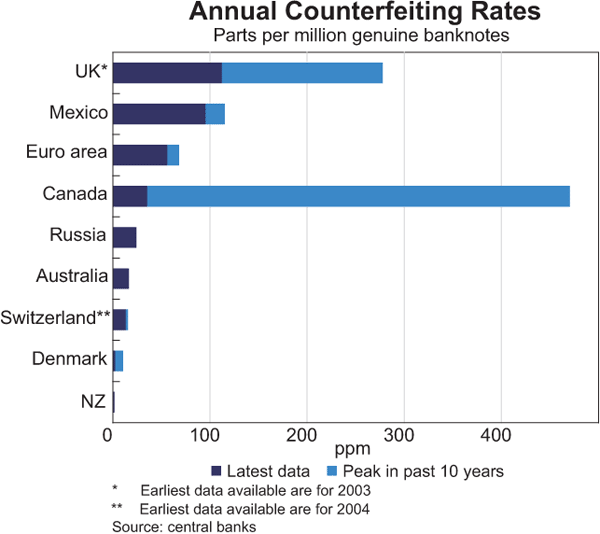
Although there have been examples of all denominations of Australian banknotes being counterfeited, the most commonly counterfeited denomination is the $50 banknote; over the past 10 years, almost 80 per cent of all counterfeits detected have been of the $50 denomination (Graph 5). The most plausible explanation is that the $50 denomination is a relatively high-value banknote and, representing almost half of all banknotes on issue, is widely used and accepted. While the $100 denomination offers counterfeiters a greater return for each counterfeit produced, the risks of detection and prosecution are higher because $100 banknotes are not as widely circulated and are, therefore, likely to be scrutinised more closely by the public.
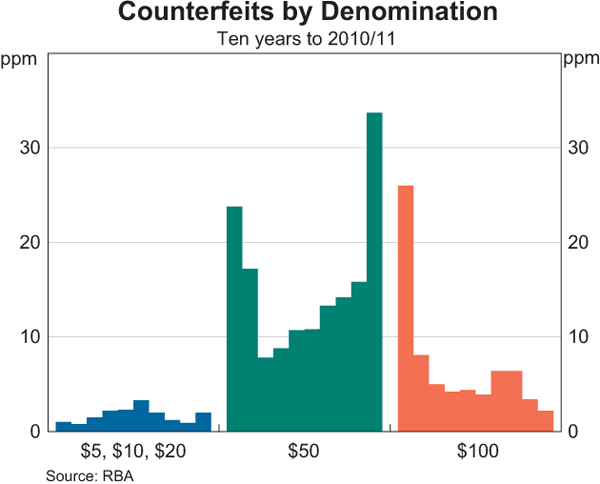
Australia's experience in this regard is not dissimilar to the experience internationally. In most countries, counterfeiters tend to target denominations that have a relatively high value but are also widely circulated. Indeed, countries in which the most circulated banknote accounts for a very large share of banknotes in circulation typically observe that counterfeits are disproportionately concentrated in that denomination (Graph 6).
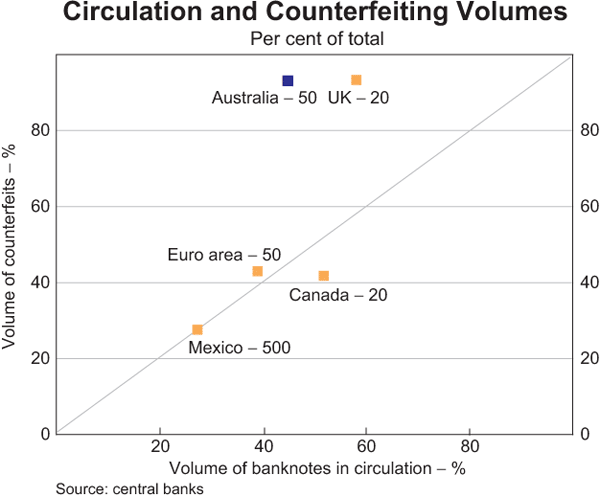
The Importance of Public Confidence
Given the importance of currency as a medium of exchange and store of wealth, it is important that counterfeiting rates are low and that the public has confidence in the integrity of the currency. If counterfeiting rates are high enough to cause consumers and businesses to become concerned about the likelihood of receiving a counterfeit, they are likely to adjust their behaviour when accepting banknotes, leading to potentially significant costs to the community. For example, businesses may take considerably more time verifying the banknotes they receive, thereby increasing transaction costs. Businesses may also need to invest in counterfeit-detection equipment and spend additional time training their staff in counterfeit detection. In more extreme circumstances, public confidence could erode to the point that consumers switch from using banknotes to alternative payment mechanisms.
If a counterfeiting threat were sufficiently serious to warrant the replacement of a banknote series, the costs borne by the currency issuer – including the development, production and issuance of new banknotes – would also be significant. The community would also bear the cost of upgrading equipment that accepts, dispenses and processes banknotes.
The Role of the Reserve Bank
Because of the potential costs to the community, the Reserve Bank has established a number of strategies to minimise the risks of counterfeiting and maintain public confidence in Australian banknotes. These strategies fall into four broad categories: research into banknote security; maintenance of the quality of banknotes in circulation; community engagement; and liaison with law enforcement agencies.
Banknote research
Australia's current banknote series, which was introduced in the mid 1990s, incorporates a number of security features (Box A). These features serve two functions: to provide the public with the means to readily authenticate their banknotes, and to make the banknotes relatively difficult for a counterfeiter to successfully copy. Given rapid improvements in reprographic technology over the past decade, the Reserve Bank devotes significant resources to keeping abreast of developments in technology and banknote security features.
The Reserve Bank has a substantial research program aimed at assessing and developing new security features that could be incorporated into future banknote designs. Given the specialist and highly technical nature of this development work, it often involves collaboration with other entities, including research institutions and universities. The Reserve Bank is also involved in a number of international initiatives aimed at combating counterfeiting, including the Central Bank Counterfeit Deterrence Group (CBCDG), a working group of 32 central banks and banknote printing authorities. The CBCDG monitors and investigates emerging threats to the security of banknotes. In particular, the CBCDG supports, develops and deploys technologies designed to deter the use of digital equipment to produce counterfeits.
Banknote quality
The Reserve Bank also has a program aimed at maintaining a high quality of banknotes in circulation, in order to not only improve the functionality of circulating banknotes, but to make it harder to successfully pass counterfeits into circulation. Overseas studies have shown that the public finds it harder to accurately distinguish between a worn (poor-quality) banknote and a counterfeit than between a new (good-quality) banknote and a counterfeit (Klein, Gadbois and Christie 2004). Furthermore, if the quality of banknotes in circulation is highly variable (with some very worn and others relatively new), the public may become indifferent to variations in banknote quality and more likely to accept a counterfeit as simply being a poor-quality banknote.
Community engagement
Another element of the Reserve Bank's strategy is public education on how to detect counterfeits. The Bank's website provides information on the design and features of Australian banknotes and counterfeit detection. The Bank also produces and distributes counterfeit detection guides to organisations such as banks, retailers and fast food outlets, and gives presentations on banknotes to groups including schools, retailers, community groups and law enforcement agencies. While having secure and good-quality banknotes in circulation makes it harder for counterfeiters to produce and successfully pass counterfeits, it is not possible to prevent counterfeiting altogether. For this reason, the public also needs to be familiar with the security features on banknotes, so that any counterfeits are readily identified and removed from circulation. In addition, in the event of a counterfeiting attack, the Reserve Bank would need to ensure it has the capability to communicate effectively with the public in order to contain the impact of the threat on public confidence. Overseas experiences have shown that even countries that have traditionally experienced low counterfeiting rates are susceptible to a sharp deterioration in public confidence, notwithstanding that the counterfeiting incidents might be relatively minor. Hence, as do other central banks, the Reserve Bank devotes substantial resources to ensure public access to information about banknotes.
Law enforcement
The fourth element of the Reserve Bank's strategy is to assist law enforcement to deter and prosecute counterfeiters. Under the Crimes (Currency) Act 1981, it is an offence to produce, pass or possess counterfeit banknotes in Australia, with maximum penalties ranging between 10 and 14 years’ imprisonment and fines of up to $75,000. While the Reserve Bank does not have any investigative powers, it works closely with state, territory and federal law enforcement agencies, assisting them to identify counterfeiting threats quickly and providing forensic support.
All counterfeits discovered in Australia, whether detected in circulation or seized by police before entering circulation, are inspected by the Reserve Bank's counterfeit examiners. In addition, the Reserve Bank supports police investigations into counterfeiting. The Reserve Bank's counterfeit examiners regularly provide police with technical advice on manufacturing techniques and materials used by counterfeiters. The counterfeit examiners also provide expert witness statements for use in court and have testified in cases involving Australian and foreign banknotes.
Recent Experience
Although over recent years counterfeiting rates have been low, the Reserve Bank continues to closely monitor counterfeiting activity in Australia and respond quickly to public enquiries. There was a significant increase in counterfeit-related enquiries late last year, due to an email being circulated that contained incorrect advice about how to identify counterfeits, rather than in response to any specific counterfeiting event (Graph 7). The email in question incorrectly indicated that banknotes without the name printed under the portrait, or with the signature of the Governor of the Reserve Bank below the signature of the Secretary to the Treasury, were counterfeit. These differences reflect minor design changes that were made to Australian banknotes in 2002. The presence or absence of printed names, and the order of the signatures, cannot be used to establish the authenticity of a banknote; there are genuine banknotes in circulation with printed names, and genuine banknotes without printed names.
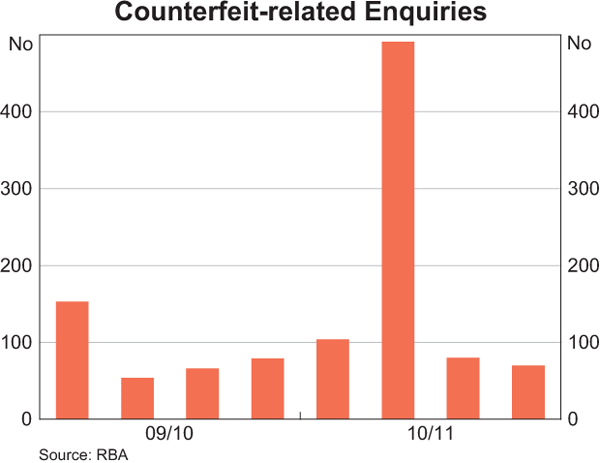
The extent of the anxiety generated by the email prompted the Reserve Bank to post a warning on its website in late November.[1] Following the publication of this warning, and the related media coverage, the number of counterfeit-related enquiries quickly returned to levels consistent with previous experience.
Box A: Australian Banknote Security Features
1 Plastic Banknote
Australian banknotes are printed on plastic, which means they have a distinct feel and it is difficult to start a tear along the edge. A plastic banknote ‘scrunched’ in the hand should return to its original form.
2 The Clear Window
The clear window should be part of the banknote and the white image printed on the window should not be easily rubbed off. The window should also contain a clear embossed image – a wave pattern on $10 banknotes, and the value of the banknote on $20, $50 and $100 banknotes.
3 The Coat of Arms
When the banknote is held up to the light, the Australian Coat of Arms should be visible.
4 The Federation Star
Diamond-shaped patterns are printed inside a circle on both sides of the banknote. When the banknote is held up to the light, the patterns should line up perfectly to form the seven-pointed Federation star.
5 The Distinct Feel of the Printing
A special raised ink gives the banknote a distinctive feel.
6 Print Quality/Microprinting
The background printing should be sharp. In particular, micro-printed text should be clearly visible under a magnifying glass.
7 Fluorescent Properties
With the exception of the serial numbers and designated UV patches, the banknote should not fluoresce under a UV light.
Additional information about the security features on Australian banknotes can be found at http://banknotes.rba.gov.au/counterfeit-detection/list-of-security-features/.
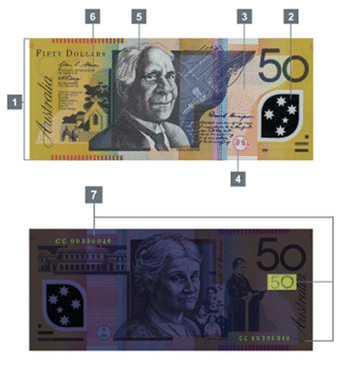
Summary
Counterfeiting rates in Australia continue to be low in both an absolute sense and relative to rates experienced overseas. As a result, public confidence in Australia's banknotes remains high. Historical experience in Australia and overseas shows, however, that counterfeiting rates can increase sharply in a short space of time and, even when there is little cause for concern, public confidence can be easily reduced by incorrect information. For these reasons, the Reserve Bank continues to review and develop its strategies aimed at minimising the risks of counterfeiting and maintaining public confidence in banknotes.
Footnotes
The author is from Note Issue Department. [*]
See http://banknotes.rba.gov.au/counterfeit-detection/list-of-security-features/. [1]
References
Bagnall J and D Flood (2011), ‘Cash Use in Australia: New Survey Evidence’, RBA Bulletin, September, pp 55–62.
Klein RM, S Gadbois and JJ Christie (2004), ‘Perception and Detection of Counterfeit Currency in Canada: Note Quality, Training and Security Features’, in RL van Renesse (ed), Optical Security and Counterfeit Deterrence Techniques V, Proceedings of SPIE Volume 5310, SPIE, Bellingham, pp 1–12.